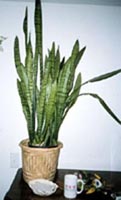Resource Library
Plant of the Week: Snake Plant (Mother-in-Law's Tongue)
The University of Arkansas System Division of Agriculture does not promote, support or recommend plants featured in "Plant of the Week." Please consult your local Extension office for plants suitable for your region.
Plant of the Week
Mother-in-Law's Tongue, Snake Plant
Latin: Sansevieria trifasciata

If all houseplants were as tough as the snakeplant, there would be no reason for the
foliage plant industry. This plant just won’t die.
Well, perhaps that is an overstatement, but short of submerging the roots in stagnant
water for months on end or a sudden freeze when you forget to bring it in from a wintertime
"sunning", it is almost indestructible.
There are two common versions of snakeplant, the green-leafed form has gray cross-bands.
The fleshy, sword-like leaves grow up to three to four feet long. They arise from
an iris-like rhizome. Its variegated counterpart, Laurentii, has a yellow band to
the leaves. The dwarf form, birdsnest snakeplant, grows in a rosette only six inches
high.
Snakeplant is a member of the century plant family, and like other members of this
family, hails from desert regions, in this case southern Africa. Old plants occasionally
flower, usually in late winter or early spring, on three-foot long stems bearing small,
tubular fragrant, greenish-white flowers that are more interesting than beautiful.
Sansevieria is a good introductory plant for children because its toughness instills
confidence, its slow growth teaches patience and all sorts of interesting things can
be done with it.
One of the common names for sansevieria is bow-string hemp, taken from the fact that
Africans used the fibers from the plant to produce the strings for their bows. Pulverizing
a few leaves to extract the fibers might be a fun but somewhat messy project. Snakeplants
can also be propagated from leaf cuttings with leaves cut into three-inch long segments
and these then stuck in soil – with the bottom end down. In about three months, the
plants will root and send up a new shoot. If the variegated form is propagated, it
will produce a normal green shoot because the plant is a chimera – a kind of mutation.
Snakeplants became popular across the U.S. because they were one of the plants, along
with African Violets, that Woolworth stores sold in the 1920's and 30's. The Florida
foliage plant industry had its start growing these plants for distribution to that
chain.
Snakeplants survive in about as low a light level as you would encounter in the home.
They may not grow in these really dimly lit recesses, but they will sit there just
the same – and with an occasional dusting – will be as good as the day they were placed
there. They don’t need a lot of water and fertilization seems optional, at least when
the plant is inside. If you want your plant to grow, move it to the patio in the summer
and give it an occasional shot of fertilizer and an occasional watering.
Keep snakeplants rootbound for best effect. I like to transplant my plants when the
expansion of the rhizomes cracks the clay pots in which they are confined.
By: Gerald Klingaman, retired
Extension Horticulturist - Ornamentals
Extension News - February 5, 1999
The University of Arkansas System Division of Agriculture does not maintain lists of retail outlets where these plants can be purchased. Please check your local nursery or other retail outlets to ask about the availability of these plants for your growing area.